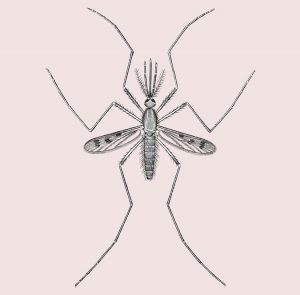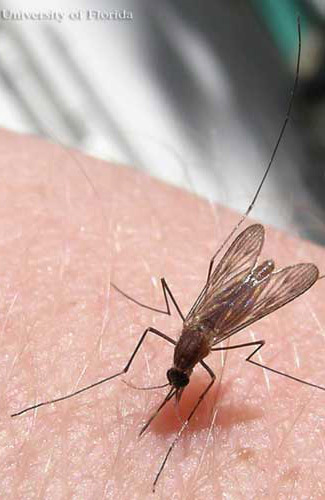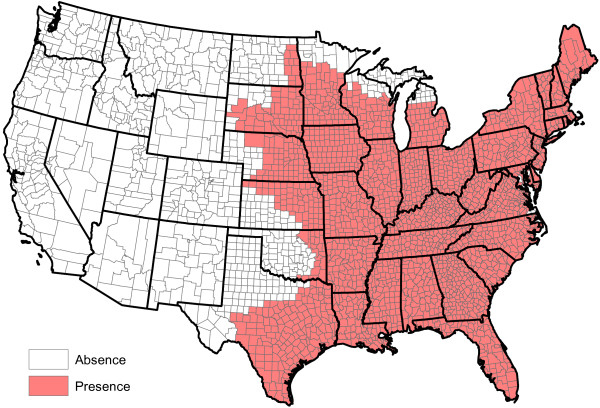Anopheles Quadrimaculatus
 Anopheles quadrimaculatus, also known as the malaria mosquito, is historically the most important malaria vector in the United States. Malaria was widespread in the United States for centuries until its final eradication in the 1950s. Unfortunately, malaria keeps popping up in the United States. According to the CDC about 1,500 cases of malaria are diagnosed in the United States each year. Most of these are cases of “airport malaria” where a person contracts malaria in West Africa or Southeast Asia and is later diagnosed in the United States. However, at times a local Anopheles quadrimaculatus bites someone who contracted malaria abroad and transmits the disease locally upon biting additional people. Anopheles punctipennis is also a potential spreader of malaria in Northern Virginia and the greater Washington DC area. Both mosquitoes have been responsible for locally transmitted cases of malaria in our area in the past. Once a mosquito contracts malaria, it remains infectious for life.
Anopheles quadrimaculatus, also known as the malaria mosquito, is historically the most important malaria vector in the United States. Malaria was widespread in the United States for centuries until its final eradication in the 1950s. Unfortunately, malaria keeps popping up in the United States. According to the CDC about 1,500 cases of malaria are diagnosed in the United States each year. Most of these are cases of “airport malaria” where a person contracts malaria in West Africa or Southeast Asia and is later diagnosed in the United States. However, at times a local Anopheles quadrimaculatus bites someone who contracted malaria abroad and transmits the disease locally upon biting additional people. Anopheles punctipennis is also a potential spreader of malaria in Northern Virginia and the greater Washington DC area. Both mosquitoes have been responsible for locally transmitted cases of malaria in our area in the past. Once a mosquito contracts malaria, it remains infectious for life.
Unlike other kinds of mosquitoes that lay their eggs in groups, the female Anopheles quadrimaculatus lays them individually. The eggs are unique because they have floats on both sides to keep them on the water’s surface, whereas other mosquitoes’ eggs stick together and create an egg raft or are laid above the rim of the water. Anopheles quadrimaculatus eggs can hatch anywhere from two days to three weeks, depending on the climate. In general, Anopheles quadrimaculatus prefer unpolluted waters and are thus usually absent from habitats that contain rotting plant material or are contaminated with animal feces. Generally, it takes about three weeks for Anopheles quadrimaculatus to go from egg to adult in their aquatic stage. They are crepuscular or nocturnal, so their activities like biting and laying eggs happen at dusk or at night.
 Anopheles quadrimaculatus larvae are found in permanent freshwater in sluggish streams, canals, ponds, and lakes containing surface-growing or emergent vegetation or floating debris, and only occasionally in pools of a temporary nature. The larvae feed almost entirely upon small organisms at the water surface; they do not appear to make any selection of their food, but ingest any material small enough to be swept into the mouth by the mouth brushes.
Anopheles quadrimaculatus larvae are found in permanent freshwater in sluggish streams, canals, ponds, and lakes containing surface-growing or emergent vegetation or floating debris, and only occasionally in pools of a temporary nature. The larvae feed almost entirely upon small organisms at the water surface; they do not appear to make any selection of their food, but ingest any material small enough to be swept into the mouth by the mouth brushes.
The females of Anopheles quadrimaculatus are active feeders on humans and wild and domesticated animals. The males feed on plant nectar and sugar sources. The adults are active principally at night and rest in dark corners in buildings, underneath houses, in stables, in hollow trees, and other shelters during daylight hours. They are very active for a short period after dusk. During the remainder of the night, their activities are limited to flights in search of a blood meal until another active period at dawn after which they shift to day time resting places.
Even though Malaria was thought to be eradicated, there are reports of locally transmitted cases in the United States spread through bites from the Anopheles quadrimaculatus. In Virginia, for example, there are generally around 50 to 70 cases of locally transmitted malaria each year. Since there are still mosquitos borne illnesses about, it’s essential to protect ourselves from their bites.
* Drain any standing water in your yard possible (natural or artificial containers)
* Dress in light-colored, loose-fitting clothes (mosquitoes like the dark colors better and can bite easier through tighter fitting clothing)
* Defend yourself with insect repellant and by signing up for an all natural mosquito service from a company like Mosquito Musketeers.

